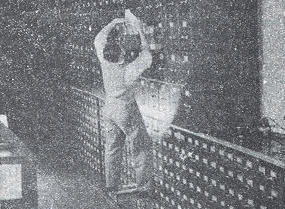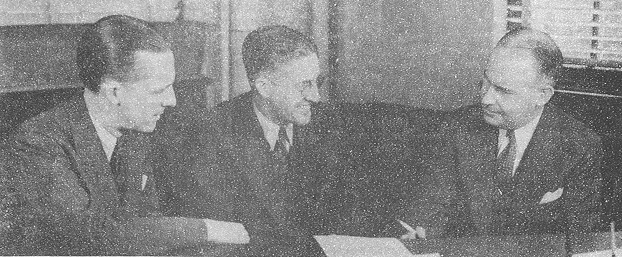The Bureau-A Profile
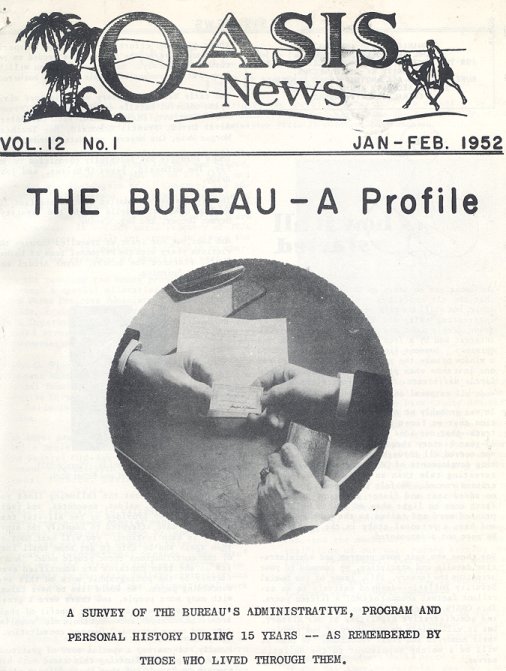
IN THE BEGINNING
1936- 1939
On August 14, 1935, President Roosevelt signed the Social Security
Act. On August 23 of that same year he appointed a three-man Social
Security Board to administer the Act. The Bureau of Federal Old-Age
Benefits was set up to administer Title II (Old-Age Insurance).
The first problem was simple enough. We didn't have any money. Soon after the Act was passed, Louisiana's Huey Long got up on his feet and didn't sit down again until Congress had adjourned for the season. One piece of unfinished business that Senator Long interrupted was an appropriation to start the Social Security Board on its way. It was not until February of 1936 that Congress finally got around to giving the Board its due ($l million), with which to operate for the remainder of that fiscal year.
In the meantime the money problem was handled through a special allocation of funds made by the Works Progress Administration and also some space, equipment, and personnel lent to us by the Department of Labor. In this fashion the Board struggled through until the February appropriation.
John G. Winant (Chairman) Arthur Altmeyer, and Vincent Miles were the original members of the Social Security Board; and under them were Executive Director Frank Bane, Coordinator Henry P. Seidemann, and General Counsel Thomas P. Eliot.
The three program Bureaus under the Board were Public Assistance, Unemployment Compensation and Federal Old-Age Benefits; and the staff bureaus were Research and Statistics, Informational Service, Business Management, and Accounts and Audits.
Francis McDonald--in talking over this early Board set-up--made special mention of the invaluable contributions made by General Counsel Tom Eliot and Louis Resnick, Director of the Bureau of Informational Service. Mr. "Mac" feels that the Bureau's load was lightened immeasurably by the early policy interpretations made by Mr. Eliot and the informational work done by Mr. Resnick.
THE BUREAU OF FEDERAL OLD-AGE BENEFITS
The Bureau started out with borrowed space as well as borrowed funds, and we were scattered all over Washington like buckshot. We became a bureau in March, 1936--not without much discussion over whether or not we should be a "service" or some other designation. It was Ewell Bartlett--then in the Office of the General Counsel--who did the spade work in determining that the Social Security Board had the statutory authority to confer "Bureau" hood upon us.
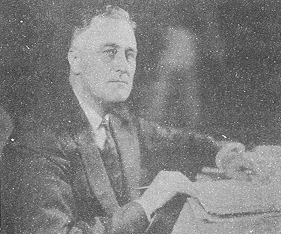 |
| President Roosevelt signed the Social Security Act--August 14, 1935 |
In the first years the Board and Bureau were split up between the buildings housing the Department of Labor, the Farm Credit Administration, and the Department of Commerce. The Board got its own quarters for the first time in April, 1936, and moved the Bureau along with it to 1712 G Street. It should be mentioned, however, that this was not the last time by any means that we sampled Washington's housing situation.
The early days of the Bureau were planning days. The big job was to get ready for January 1, 1937,--the effective date of the Social Security Act. Before that date employers had to be registered, account cards issued to employees, and the machinery set in motion for installation of our wage record keeping operations. Furthermore, lump-sum claims would start to come in toward the middle of '37, and we had to have the know-how and the personnel to adjudicate and pay these claims.
The Post Office Department ranks as one of the early social security workhorses, for it was that department which handled employer registration and account number applications. Reed Carpenter remembers well a picture in the papers of the day showing faithful postmen leaving post offices, their bags full of SS-5's, preparatory to depositing them in every home on their route. It was not until May of '37 that the Bureau took over the job of registering employers and employees, and until that time the P.O. performed yeoman service on our behalf.
ENTER-THE CANDLER BUILDING
"It looks like just what the doctor ordered." These were the historic words spoken by W. L. Mitchell upon first seeing the Candler Building and deciding, along with Reed Carpenter, Joe Fay, and others, that the search for record keeping space was over. Many who read that remark may see a good deal of irony in it, but for the purposes for which the Candler Building was originally chosen, it actually did fill the bill.
Back in 1936, the Candler Building was only a "temporary" location. People transferred from Washington, recruits flocked in from all over the country with the practical certainty that the Candler operation was at most a six-months expedition. In retrospect, it seems like a mighty long six months.
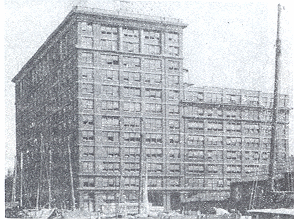 |
The reasons that Candler was considered a temporary proposition take us back in our narrative to the days before the Baltimore move was made. Right from the beginning the Social Security Board buckled down to the job of setting up and maintaining the complex system of wage records which were needed to carry out the provisions of the Act. Those criticisms of the law which were directed toward the impossibility of administering its provisions were directed almost entirely toward the wage record operation. Private insurance companies and foreign governments which had social security programs were particularly skeptical about this phase of our operations, and many confidently predicted the social security program would collapse because of it. (It didn't!)
In order to set up the record keeping system, a small staff of experienced technical experts, including among others Joe Fay, Tom McDonald, E J. Way, and Charlie Beach, was recruited from other government agencies. This whole group was under the direction of Murray Lattimer and Henry P. Seidemann (later the first two Bureau Directors). It is almost impossible to convey the job which confronted these people in the earliest days. Should we use a stamp plan method of reporting? Even the Act itself mentioned stamps, coupons, ticket books "or other reasonable devices." One of the "reasonable devices" was the payroll method. It and the stamp plan became the chief competitors, with the former winning out.
Should we use a punch card system, or were there other record keeping methods which were more practical? There weren't, and we took the punch card road.
And finally, should we house all our records in one building and administer them centrally, or decentralize the operation out to the Regions? Originally we set up all the records in the Candler Building, but we divided them into 12 Regions to parallel the field set-up. This was done with the view in mind of actually transferring these records out to the regions when the proper administrative time arose.
It never did. By 1938, recommendations from Mr. Fay and the "Pois" survey disclosed that decentralization of records would never be practical. There were many reasons for this. In the first place, large employers file in one region for employees working all over the country. Secondly, workers shift from place to place, and this made necessary the constant transfer of their records from region to region. Finally, some of the problems were nationwide in scope (i.e., incorrects. and incompletes), and it was a tremendous job to handle such problems region by region.
|
|
| Candler Regional set-up complete with local acrobat |
Shortly after the Pois survey, the Board decided that the regional plan was impractical, and we shifted over to our present centralized method. That decision was the one that made the Candler operation no longer "temporary."
These early problems and decisions seem simple enough in the telling, but let's see how one of the early planners (Tom McDonald) remembers the work necessary to get under way: "Every morning we would meet and sit around a big table in Washington. Everybody had his own ideas about what the program meant, and everybody's idea would be taken down and typed up and discussed. We'd leave home in the morning and not get back again until 3 or 4 the next morning. The brass would have to go to Congress the next day, and we'd have to develop material mostly within an hour. We'd build up a budget from what Congiress and Board people said on a particular day. Congress would ask how much money we'd need for the next 6 months, and we'd wonder if our estimates were even close to being right. Then, within a week the whole thing would have been thrown out, and we would start over."
|
|
| EARLY RECORD PLANNERS---TOM MCDONALD, CHARLIE BEACH, AND JOE FAY |
Featured in the early days were the machine companies. J. J. (Obie) O'Beirne has the names of over a hundred who were contacted in the long ago, complete with a detailed list of the proposals submitted by those companies that had even the germ of an idea for handling our records. The choice finally narrowed down to IBM and Remington Rand. What finally swung us over to IBM was that they were able to present blueprints of machines which later became the collator and posting machines. We can point with pride here to the fact that until IBM and OASI people sat down and thrashed the thing out, no machine existed which could perform the collating operation. This machine, now widely in use throughout the country, owes its first existence to the vision o£ some of our early planners.
And now finally we come back to Candler, and what life was like when we first set up shop down on Baltimore's waterfront. Just mention Candler to some of its earliest occupants and you loose a flood of memories and humorous incidents. Candler was originally chosen because it was near Washington, it had sufficient floor strength and space to handle the enormous weight and volume that we would need. Also, it was fireproof and could be occupied on a short-term rental agreement.
Those were the advantages, but to a few of the people who first beheld its desolate splendor, thoughts other than delight seeped through their minds. "I'll never forget as long as I live the day I first walked in here," said Tom McDonald. "The only neat and orderly thing about the whole building was a bonded liquor company that occupied part of the premises. The whole place was dilapidated, empty, unpainted and forbidding. No one was too concerned, though, because we would only be there a few months."
The early days in Candler were also described by Obie O'Beirne. He remembers well the almost unlimited confusion resulting from "carpenters building and setting up partitions--the public wandering in for information--newly hired employees looking for their supervisors--and dirt, everywhere dirt up to our ankles."
The work day was another catch-as-catch-can proposition. A typical day would include a 7-hour conference by the top brass, with the underlings sitting around until 4 P.M., awaiting orders. Then--bango--at 4 the meeting would end and all Sam Hill would bust loose. Figures were needed for the next day's meeting--conference decisions had to be carried out, and the work force would stay on until 10 P. M. and really work. "It was a madhouse," says Obie, "but it was fun; it was busy; and it was exciting."
And so Candler was off to the races, never again to be headed at the turns or swayed from its appointed task. The only missing item is the recruitment of personnel--a big item at that, and one which we shall reach in due time. Back to Washington for a minute, though.
THE CLAIMS ARE COMING
Everything now performed in Claims Control, Claims Policy, and the adjudication work of the Field was handled in the old Claims Division. General Counsel also played an active role in policy development; but, in general, the Claims Division was the focus for adjudication and interpretation. Its early Chiefs included Francis McDonald, Bill Tackaberry and O. C. Pogge. A visitor--wandering through the small space that then housed the whole division--would have discovered such later day luminaries as Jim Tully, Mandel Benjamin, Joe Columbus, Dick Branham, Charlie Erisman, Lou Lange, Joe Carmody, Lou Zawatzky, Jim Murray, Tom Gary, Les Griffith, Gus Meyers, Odin Klovstad, Mercia Leton, John Shelton, George Keating, and A1 Frankfort seated facing each other at their desks, sleeves rolled up, banging out 40 to 50 cases a day.
Gladys Jorgensen (later Dick Branham's wife) was down the hall with her three or four clerks, performing the scheduling, vouchering, accounting and control functions which now take many times that number of people in each of 6 area offices.
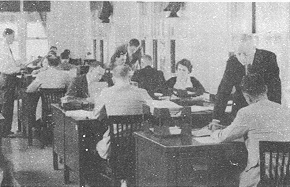 |
| Adjudication Section--Claims Division, Washington approx. 1938 |
Lou Zawatzky, recalling those days, remembers many dissimilarities with present times. Most vividly he recalls that everyone had an "acting" job. "They were acting this or acting that--we had more actors than Actors Equity." Also he remembers that times and jobs were changing so fast that "a guy thought he was in a rut if he didn't get promoted at least once every 6 months."
Generally, Louis was most impressed by the contrast between the "compartmentalization" we now have and the lack of it in our earlier days. Today we have rather clear-cut organizational lines, large and specialized staffs, and areas of work which are pretty clearly defined. Not so in '36. Back then everybody knew everybody else's business, and the Bureau in Washington contained a relatively small number of people working under the general outline of an organizational pattern rather than in well established channels.
One of the times Lou best remembers was the day the Supreme Court decision was announced upholding the constitutionality of the Social Security Act. The NRA and some other New Deal measures had been KO'ed by a series of negative decisions, and there was quite a bit of tension while the decision on our Act was awaited. There was a good deal of celebration when the favorable news arrived.
During all the time that we were beginning to overcome the claims and wage record problems, the third parallel arm --the Bureau-- was also growing some muscle. By the end of 1936, the Regional set-up was already established, and field offices were beginning to dot the land in sizable numbers.
FROM MAINE TO WASHINGTON
The Field organization did not grow out of one single plan which was acceptable to everyone from the beginning, any more than did the other segments of the Bureau. The original discussions and proposals were as numerous and varied as those for the handling of claims and wage records. A Regional organization was pretty much assured, since this was an obvious way of coordinating the field organizations of all the constituents of the Social Security Board. Originally there were twelve Regions, a set-up which lasted until August, 1948, when the Regions were redistributed and reduced to 10.
Planning for field offices was something else again. Serious proposals we resubmitted and considered for a field organization consisting of anywhere from 300 to 2,000 offices. In actuality, we announced the location of 100 offices by December, 1936, and by then 71 were in actual operation.
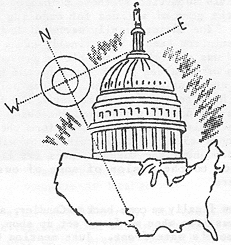 |
The big initial job in the field was public contact work. Remember that the Post Office was handling the issuance of account applications and cards, and no claims came in until the Summer of '37; but, in addition to the job of getting organized and ready for the big job ahead, there was plenty to do. From the beginning, we were busy working out procedures and methods with the Post Office Department and the Bureau of Internal Revenue. We had to make extensive employer contacts (estimates from various people interviewed run as high as 50 contacts a day, but there is a healthy disagreement on this point) and, above all, we had to answer the telephone. Everybody who even passed through a field office on a visit, including the Regional Reps., was put to work on the telephones. They rang all day, and nobody was ranked too high for this job.
Also, at this time we helped out the Post Offices in every way that we could. Many of our clerical people were stationed temporarily in the P.O.' s banging out SS-5's.
This preparatory job lasted only a short while, though, for by July of 1937 we were deep into the account number business on our own. At this point it is well to let Hugh McKenna take over the story, for the impact of this load can only be told through the words of an active participant.
"Original estimates were that the Act would cover about 26 million people, and we thought that by the time we took over the job from the Post Offices the bulk of the account numbers would have been .issued. The best guess was that we would then be getting about 12,000 account numbers a week. This was the figure worked up by Ben Beecher and myself. We discussed it thoroughly with all the powers that were, and there was general agreement on the estimate.
"So--we doubled the figure. And we still didn't even come close. The load at the 45 Broadway Field Office alone exceeded our estimates.every week. We never did get down to the figure originally proposed, and we never have yet.
"Naturally, this put us way off on our staffing estimates too. The field offices started yelling for help and hiring people for all they were worth. I can remember John Corson sending me to New York in 1937 to find out what they were doing with all those people. I came back with the report that they needed them all, and John told me, 'You're a hell of an operator'; but he agreed with me, and we kept them."
One of the devices used to handle this work load was to set up typing centers in the Regional Offices to take care of the overflow. Field Offices were urged to send their backlog to these centers for processing, and the typing centers went full tilt. But there were many stubborn pioneers in the early days. Reg. Crosby tells the story of one of them. He was up in the Boston Regional Office at the time, and was sent out to see how things were going in the Portsmouth, New Hampshire, Field Office.
Chet Norman, now Manager in Jamestown, N. Y., was the head of the Portsmouth office at that time, and he was called upon to explain the fact that his office wasn't sending any work into the typing center. Said Chet, "My staff just isn't having any of that stuff. They won't have any truck with backlogs. I've made it a rule to go home at 10 P.M. every night. I can't take any more, but some of my people stay around until midnight. No backlog."
Portsmouth was not unique either. There were many similar examples in the field. Work hours in those days were, to say the least, flexible, and compensatory leave was an unknown phrase.
In the early days--in fact up until July, 1940,--there were eight classes of field offices. This was reduced to seven in 1940, to four in 1943, and finally to three in 1947. One of the early anecdotes which gives some indication of the size of Class 8 and 7 offices refers back to the days when Bill Fitch--now New York Area Office Chief--was manager of the Ithaca, New York Office--a Class 7 bailiwick. Periodically, he would send in reports to McKenna--then Regional Rep. in New York--which would include the grand total of no claims for the week. This brought forth the remark from the Reg. Rep. that, "I see there's tight pitching up in Ithaca. They were shut out again."
And so, for the moment, we must leave the field and turn our attention briefly to the public and how they felt about all this.
 |
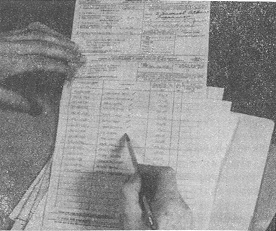 |
THE PUBLIC REACTS
Mostly, they reacted favorably. The largest direct impact we felt was from our employer contacts. Work with machine outfits, with insurance companies, with employers for reporting purposes--this is where we were partially able to judge the public's attitude. To those who looked back upon these contacts for us, it was unanimously agreed that employers were most cooperative. Not only did they respond to our requests for information and assistance, but they also, in many cases, made suggestions which were extremely helpful to the early planners.
Generally, this employer attitude was a reflection of the over-all public reaction, but the flavor of the period can be pointed up better by relating some of the incidents that occurred. They prove nothing, since they are generally not indicative of a consensus, but our story would be incomplete without them.
ITEM--Originally, we didn't issue account number cards to persons over 65. Result--a man came in to see Hugh McKenna in Philadelphia when the Regional Office was also acting as the field office and demanded an account number because he didn't want his employer to know he was that old. He was refused because we just didn' t issue them to the over 65'ers. Said he to McKenna: "I'm going out and get me a gun and come back and shoot you--and FDR too."
ITEM-From Nate Freedman. One frequent question from the public was: "When do we get our money?" The program didn't mean much to them in the days when all the money was going into the Trust Fund and none of it was going out.
ITEM--We weren't popular in Baltimore in the early days. Government workers were looked upon as being somewhat better than untouchables, and we found our bank credit low and our room gents high. "You'd have thought we had smallpox," said Tom McDmnald.
Some of the unfavorable reaction was more widespread, however, than these isolated incidents. One of the biggest problems we had at first was to overcome public fear of regimentation. Early Board proposals included issuing metal discs (called dog tags) as account number identification, and placing thumbprints on the SS-S's. Both these proposals were rejected early in the game, but the public got stirred up about their implications. It got serious enough to be a Landon campaign issue in 1936, and John Winant resigned as Chairman of the Board in order to campaign against these charges of regimentation.
By far the most serious of the early unfavorable reactions, however, were the "John Does." In the early days, unidentified wage items were as high as 11%, and many of these unidentified items were actually sent in with the name John Doe on them. (Hence "John Does.") The 11% figure did not exceed our estimates, for it was to be expected when the program was so new. However, Drew Pearson got hold of one of our Director's Bulletins giving the figures on the John Does and really made hay with it. Almost every week he printed something on the subject, harping on the theme that a large amount of taxes were being paid in and not being credited to the proper accounts. Naturally, the public and Congress were unhappy about this, and it wasn't until we could show by our quarterly statistics and through the installation of the collector letter procedure that we had the problem under control that we got out of the woods.
So much for the early public reaction. As mentioned earlier, we have highlighted the humorous and the negative reactions out of proportion to the true picture. In general, the public was with us and has had no cause to change its mind ever since.
YOU HAVE TO HAVE A STAFF
The Board opened for business in 1936. This was still very definitely a depression year; it was also a year for Supreme Court vetoes and the shutting down of some ill-fated New Deal agencies. These factors combined to make the Bureau's personnel job one of selection rather than recruitment.
Some of the top brass came from other agencies. Before our wage records system was set up, the Treasury Department, the AAA, and the Census Bureau had the big governmental machine operations. Consequently, almost the whole present hierarchy in DAO came from these three agencies. Messrs. Fay, McDonald, Baker, O'Beirne, Kreps, Dewey, and Shields all migrated from these three. Elwood Way and Charlie Beach--early records planners--also were from the same ranks. Somehow or other, Joe Columbus arrived via the AAA route, and he was a claims man from the very beginning--the exception to prove the rule.
The NRA contributed W. L. Mitchell, Reed Carpenter, Howard Dunn, and Sherwood Avery; Francis McDonald, Lou Lange, Ernie Tallman, and Dick Toomey were VA men. Maurice Dewberry, Jim Murray, Pinky Lupton, and Ray Jordan came from other government outfits; John Campbell and Al Kuhle were private insurance men; Joe Tighe and George Rawson came from other non-governmental pursuits.
The Civil Service Register for Junior Personnel Clerks (Grade 3) was the most fruitful source for recruitment for the vast majority of positions. It was the closest thing to the JPA Register at that time. Many of the people in those days were placed in one unit in the Personnel Section and then farmed out to other units as the calls came in. The units would then decide whether or not to keep them on a permanent basis. As field offices began to open, many of these recruits headed for the hinterlands to join the great majority of field recruits who were selected from regional registers in field office locales.
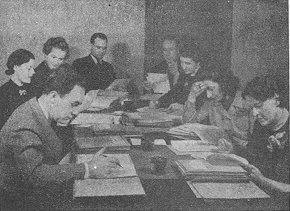 |
| Part of the Personnel staff 1937: Mary Page Spinning, Ruth Hathaway Lane, Minnie Brunett, Mayme Arcuri, and Esther Sholl are among those present and still with us. |
For the first year, however, the big recruitment story was in Candler; and the people to tell it are Esther Sholl, Florence Von Schulz, Mayme Arcuri, and Mary Page Spinning. It was in the aforementioned smoke-filled room that they spun their story, and the following narrative is based entirely on it.
"Our biggest day was December, 7, 1936, when some 940 people entered on duty. People lined up all the way down the stairway and around the huilding, and we finally wound up the proceedings at 5 a.m. Every person entering on duty had to complete three or four copies of the forms, so it took hours for them to be processed. They just had to stand in line and wait it out. No accommodations for food--it was hectic." (Sholl)
DAO opened up officially on November 9, 1936, with 18 people. Three weeks later they had 991. During this interval, the personnel people were, shall we say, busy. The ratio of people applying for jobs to the number of those hired was 20 to 1, and the qualifications of some of them were astounding. These were depression days, and many were the Ph.D.s and Phi Beta Kappa's who punched cards along with the best of them.
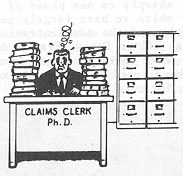 |
The Personnel Office itself was a three-ring circus. Rules, regulations, and instructions added up to one thin little book as compared with the volumes that are in existence today, and the Personnel staff just learned as they went along. Normon Milburn was the first head of the Bureau's Personnel Section, and to him the four girls give much of the credit for starting us along the road to a well-organized personnel program.
One of the keys to our early personnel situation was the fact that "apportionment" was in effect. and we could only recruit a certain ratio from each State. We were able to attract people from all over the country, but only because the Candler operation was thought to be temporary, and people were placed in "Regions" in Candler which corresponded to their home environs. They fully expected to be sent back within 6 months. This "apportionment" problem incidentally was one of the reasons Baltimore did not take to us too readily. The city had big unemployment problems, and here we sat in their midst bringing in people from all over the land.
The "national" nature of our recruitment brought to us many people from small towns and different backgrounds, and their adjustment to the ways of a large Eastern city was sometimes a difficult problem for them and for the Personnel people. Housing, transportation, eating facilities, social life--all needed attention. Real effort was made to help out along these lines, but the small Personnel staff and the enormous work load left little time for this sort of work. As a result, it was quite a while before some of our workers were able to feel at home in their strange setting.
THE PROGRAM CHANGES
1939 - 1942
On August 10, 1939, the first major program changes became law. The most important provisions were those which established benefit payments for dependents and survivors of the wage earner and which advanced the date for paying monthly old-age benefits from January, 1942, to January, 1940.
The emphasis on program, thrown into bold relief by the major legislation of 1939, brings us back sharply to one phase of the Bureau's history which we have largely neglected--the philosophy and the administration of program planning. Alvin David, Francis McDonald, and Charlie Beach spoke at length on this subject, and we have tried to select the core of their thinking for this discussion.
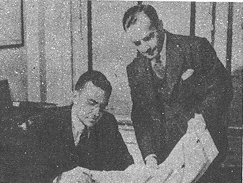 |
| John Corson certifying first schedule of monthly benefits January, 1940, as Reed Carpenter looks on. |
Probably the most fortunate thing that ever happened to social security in this country was the selection of men like Arthur Altmeyer and John G. Winant as its top administrators. Early concepts of old-age insurance leaned heavily toward the concept of its being little more than an expansion of a private insurance plan. Early personnel qualifications stressed an insurance background, and the emphasis in general was on "Insurance" rather than "Social." There is no question that the broader concept of an overall program which highlighted social purposes received its greatest stimulation from the joint wisdom and vision of Messrs. Altmeyer and Winant.
It was out of the sort of philosophy that they brought to the program that the 1939 Amendments grew. The concept of survivors' benefits was not a sudden thought on the part of one man, nor did it come in response to the efforts of any one or several pressure groups. "It was in the air," (Alvin David), for it was an obvious outgrowth of the approach to social security which was taken by its earliest leaders.
One other thought on program also needs to be mentioned before we turn to other matters. The 1939 Amendments were based on proposals from the Social Security Board and the Advisory Council on Social Security, which contained the substance not only of what later became the 1939 law, but also most of the 1950 Amendments. "Our sights were set too low on benefit amounts. The rest of the '50 law was pretty much foreshadowed in our 1939 recommendations." (David) This indicates that our program goals were fairly well defined from the early days of social security.
However, just as in all the other aspects of our administrative history, we did not start out with the sort of program planning that we now have. The present Division of Program Analysis is a far cry from 15 years ago, and the specialization that we now have differs greatly from the long ago. We only have space for a few of the highlights in this field. In the beginning, I. S. Falk's present Office of Research and Statistics was a Bureau, and headed up the planning for the Board. Our own Bureau started out with an Actuarial Division (notice the, insurance emphasis). The Analysis Division was not set up until November, 1937. An Administrative Studies Section was set up in that division, and this became the chief focus for the Bureau's work on the ' 39 Amendments.
PUBLIC REACTION
"With the '39 Amendments the field really began to feel that they had a program." (McKenna) Now that people could retire (they had to die to get any money up until this time), and that we were going to start paying monthly benefits, the public reaction became overwhelmingly favorable. Heretofore, we had had a good deal of criticism about taking money and not paying continuing benefits, and the public had not felt it was a very meaningful program. With the advent of monthly checks and survivors bensfits, all this changed.
It was wonderful for our personnel. The type of person who began to come to our field offices for service was of a different sort then before. Heretofore, we had mainly dealt with those applying for account numbers; now we got the truly grateful old people, and we saw them in large numbers. Our whole interviewing process gradually changed, for it required much closer insight into the problems of individuals than ever before--much greater tact, and meant much greater satisfaction.
A very simple thing indicated this change. Our claims "clerks" now became claims "assistants" as evidence of the altered nature of the job. Before, we had mainly handled papers--now we were really dealing with people.
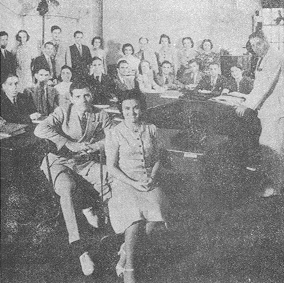 |
| An Early Training Mass--F. J. McDonald Presiding |
HANDLING CLAIMS
There were two major jobs in preparing for the impact of the tremendously increased claims load: (1) Getting the instructions written and the interpretations made; (2) Training, training, and more training.
Mr. Pogge was at this time head of the Claims Division, and it was he who headed the committee to write our first claims manual. We weren't able to plan for this as far in advance as we later did for the '50 Amendments, and it turned out to be a whale of a job. Lou Zawatzky's top memory of this operation was of the committee members working all day and more on the manual and then scheduling a committee meeting for 10 p. m. to thrash out the products of the day' s labor.
And then there were the Claims Schools. Of all the well-remembered devices in our Bureau's history these probably rank at the top. No one failed to mention them first when the '39 Amendments were brought into the conversation. They were quite an institution.
After the Claims Manual was issued in ' 39, "everybody we could lay our hands on in Washington became an instructor." (Beach) They went out to the field in droves; there was much excitement and enthusiasm about it, and attendance was almost 100%. There were five or six schools in each Region, and the trainees ranged from clerks to Regional Directors. It was a big job, and a crucial one, and one which we still look back on with a sense of genuine accomplishment.
The 1939 Amendments brought to us for the first time the problem of what type of record to keep of payments made to each beneficiary. Heretofore, all that had been required was a one-time authorization to the Treasury Department for the payment of lump sums; now we had the problem of monthly payments. Jim Tully (later Philly's Area Office Chief) was the head of the Claims Correspondence and Control Section--the nucleus of what later became the Control Division.
The Section started out with 40 people, and budgeted 140 for the coming fiscal year. They soon discovered they were going to need over 500 employees--another evidence of the early underestimation of our workloads. We had to set up procedures, forms, schedules, and work out co-ordinations with Treasury; and, most of all, we had to chart our course in an entirely new field.
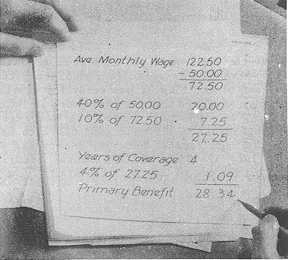 |
A punch card system was devised to take care of current scheduling and balancing of payments. The problem of an historical record of these payments remained.
Usual accounting methods suggested a ledger account for each individual on the rolls, and original proposals and practices put this method into effect. We actually bought several million ledger sheets and posted to them for a few months before it was decided that the claims folder itself would be a perfectly acceptable substitute. All pertinent material was filed in the individual's folder so that it was possible to reconstruct the payment history of any beneficiary from his folder in a matter of minutes. This system saved us hundreds of clerks we would have otherwise needed to maintain ledger sheets.
THE WAR YEARS
1941-1946
The coming of war meant problems of space and personnel. It caused the move from Washington, the setting up of area offices, and the inauguration of Wilkes-Barre.
The effect of the war years on the Bureau was very profound--yet had little or nothing to do with the social security program itself. It is true that the return of older people to employment--filling jobs vacated by servicemen and war workers--cut down the volume of claims we received, but the main effects of war on the Bureau was outside this realm and in the administrative fields of procedures, space, and personnel.
We had always looked forward to the days when the Candler operation would return to Washington and be combined in one building with the rest of the central office functions. Our dream almost came true. They built a building in Washington which was to house OASI, but they finished it just at the time space was at a premium in that city. Several war agencies immediately took over, and by the time it was ready for civilian occupancy after the emergency, we were in Baltimore and the FSA moved into the Washington building. This might be a good place to mention that the Federal Security Agency was set up on July 1, 1939, and the Social Security Board became one of its constituents.
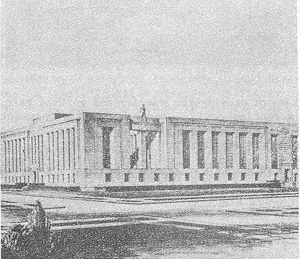 |
| "I dreamt I dwelt in marble halls. . ," |
With war agencies in our building and space at a premium all over Washington, we had to move our central offices. Many places were considered--Reed Carpenter remembers John Corson telling him to get on the phone and contact the field office managers in Cleveland, Chicago, Philadelphia, Indianapolis, and other cities to ask them to get square footage figures on all the large buildings in those cities, regardless of whether or not they were occupied. "We were desperate." But Baltimore finally became the spot. We competed with the Maritime Commission for the Equitable Building space, and won this battle. The move was made in the Summer of 1942, and we joined DAO for the duration.
Before coming to Baltimore, however, the decision was made to take an even more important step than the relocation of the central offices. Plans had been afoot for some time to set up area offices and decentralize part of the claims function. The war situation accelerated our consideration of this step from the standpoint of the need for both space and personnel, and made it obvious that it would be better to make all the moves at one time, rather than one to Baltimore and another to the Area Offices.
In June, 1942, the Philadelphia Area Office was opened, and in rapid succession we followed up by inaugurating the New York, Chicago, New Orleans, and San Francisco offices. Most exotic of these was New Orleans. Reed Carpenter still clearly recalls going out with Jim Tully and obtaining space in a furniture store for our operations in New Orleans. "I've never been forgiven for it by Ben Wilson and some of the people who went to work there."
New Orleans was one of the least happy of our locations, and this was remedied in 1946 when we replaced it with offices in Birmingham and Kansas City.
These were tough days for Bureau personnel. It meant being uprooted and sent to the four corners of the land. We lost a considerable number of people because of this relocation at a time when the labor market was getting tight and we could least afford to lose them. We went so far as to arrange to give employment with the Bureau to the husband or wife of a Bureau employee who agreed to move with us. We also asked for preferences of location from those people who were going to the area offices and were able to fulfill their requests in 90% of the cases.
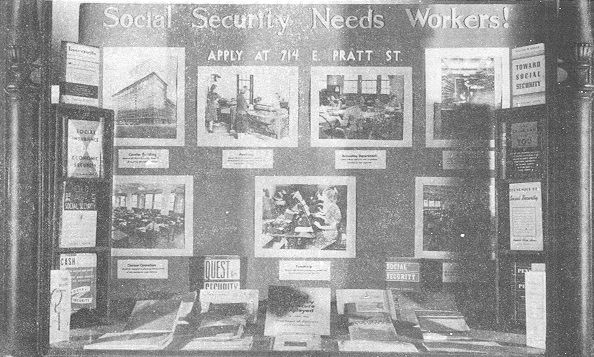 |
DAO GOES HUNTING
"We got them out of the dime stores and the wash rooms, and Esther even recruited them off the elevators in hotels," said Mayme Arcuri. "Joe (Arcuri--her hubby) was on one of the recruitment teams that scoured the countryside, and when he got back home I'd never know who or how many he'd have with him to stay for supper and overnight."
These were the days best remembered by the Personnel people in Baltimore. Turnover was tremendous, many went in Service, and the labor market was nil. We got permission from the Civil Service Commission to recruit outside Baltimore, but we got a Priority #5, which meant we stood in line until all defense agencies had their fill. We had to recruit people on the basis of "night shift, pay your own way, grade 1 jobs, plus an entrance test," while other agencies were offering "Grades 3 and 4, day shift, no test." We started out the war with 66% men and ended it with 66% women, but "we were able to recruit because we were a stable agency." "Like heck that was the reason," said Father Sholl. "We were just darn good recruiters, that's all."
We had teams out in the field all the time, starting in Pennsylvania and working North as far as Maine and Wisconsin; and still we ended up with a figure of $13.20 per person recruited. The War Manpower Commission reported that $40 was the lowest recruitment figure reported by any private industry.
In spite of these emergency measures, it was obvious that DAO couldn't pick up the number of people they needed in Baltimore. First, they tried to send some of the machine work out to the area offices, but even there the recruitment was too tough, and the Wilkes-Barre operation was born. Wilkes-Barre was discovered to be a wonderful spot by the ever-relentless recruiters, but most of the potential employees were young girls who didn't want to leave home and whose mothers wanted them to travel to the sinful city of Baltimore even less. So we opened up in Wilkes-Barre in January of 1945.
Thus it was in Candler--perhaps the most dramatic instance of our recruitment problems during the war. But elsewhere there was little difference as area and field offices joined the general scramble to keep their work forces somewhere near par.
There were other phases of personnel work besides recruitment which presented grave problems at this time. Many of our people left for service, all appointments and promotions became temporary, and a system had to be worked out whereby jobs were assured for them upon their return. Servicemen were considered for promotions even though they weren't around to fill the jobs, and a "Promotions-in-Absentia" committee was set up which worked months to establish procedures for promoting people in service. A punch card system was installed, which was used Bureau-wide, except for the field. The field was able to break the job down by Regions and administer its own system of promotions. But it was a headache for all (even though a worthwhile one), and it added a great deal to the already voluminous personnel load.
THE MODERN ERA
1946-1952
The War ended, veterans returned-we became middle-aged and paunchy, and then came the 1950 Amendments.
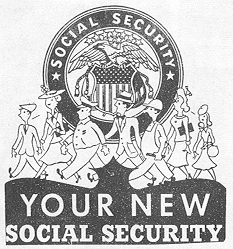 |
The reconversion period was a pleasant one for the Bureau. Familiar faces returned from the war, it had been a long time since there had been legislative action which affected our operations, and we had a chance to build a well-trained, capable, and experienced staff. Operations became clearly defined, and we had our workloads trained to sit up and do tricks. We lost one valued friend in 1944 when John Corson left his post as Bureau Director to begin managing the business affairs of the Washington Post, but Mr. Pogge had already had several years of service as Director while Mr. Corson was heading up the United States Employment Service, and he easily stepped in and took over where his predecessor had left off.
In 1946 the Social Security Board was dissolved and replaced by the Social Security Administration, but Mr. Altmeyer's appointment as Commissioner assured continuity in our program leadership.
There was, however, one serious fly in the ointment. Field people felt deeply the reaction of the public to the low level of benefits that were being paid in a period of inflation, and it got so we flinched whenever we had to face a claimant's inquiry about how much money he would receive.
Most of all, however, this was a period of planning. The '39 Amendments were in the distant past, and it was becoming obvious to everyone that benefits, coverage, and eligibility were getting far out of line. The Division of Program Analysis was burning the midnight oil preparing material for Congressional hearings, and H. R. 2893 and H. R. 6000 were becoming as familiar words as "hello" and "goodbye" around the Bureau.
But this time things were vastly different from 1936 and 1939. We were an experienced Bureau with a well-trained staff, and we went after the problem of preparing for the legislation early, carefully, and thoroughly. We knew what the problems would be, and even though we had to race around keeping track of day-to-day changes in the provisions, the main outlines of our planning were clear long before we got hit by the actual legislation.
Training went on everywhere. Field and area offices conducted their own series of programs, and F. J. McDonald & Go. were busy as beavers training the new field recruits brought into Baltimore. We got on top of the reconversion of benefits problems so fast that revised checks were in the mail a month after the law was passed
Recruitment was gradual and instead of staffing to meet peak loads, we shifted personnel between units and divisions and worked overtime--ending up with a staff we could keep permanently. Our field offices passed the 500 mark, and Puerto Rico and the Virgin Islands joined the network for the first time. Claims Policy issued PPM's and temporary instructions by the carload and kept on top of the instructional problem until they had time to start out on the new Claims Manual. DAO got hit by the peak claims loads and later by the complications in reporting that follow the registration of newly covered groups; but these were handled in stride.
The Bureau adapted itself quickly and completely to the most extensive program changes it had ever had, and proved to itself that its fifteen-year history had not only been an eventful but a fruitful one.
Who would have thought when we made our first estimates of account numbers in 1937 that in fifteen short years over 80 million living wage earners would be members of our family and that 62 million of them would be insured under the program? And, of course, program fulfillment is not yet a reality, for ours will always be a program which progresses with changing times and circumstances.
Since this is an article written through the eyes of its employees, let's let John Maze pronounce the benediction. "The Bureau has had sound, healthy, and logical growth from the very beginning. We have never had to backtrack along the way in our program development, and the public has accepted and approved our growth from the start."
